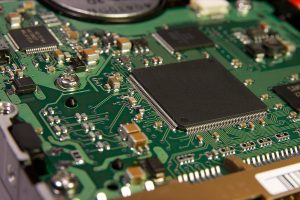Rigid-Flex PCBs: A Key Technology in Aerospace Electronic Assembly
Engineers and designers constantly seek innovative solutions to enhance electronic systems’ performance, reliability, and efficiency in the aerospace technology arena. One crucial technological advancement that has significantly impacted aerospace electronics assembly is the adoption of Rigid-Flex Printed Circuit Boards (PCBs). These specialized PCBs offer unique advantages and applications, making them indispensable in the aerospace electronics industry.
Understanding Rigid-Flex PCBs
Before getting into their applications in aerospace, it’s essential to understand the fundamental characteristics of rigid-flex PCBs. Unlike traditional rigid or flexible PCBs, rigid-flex PCBs combine rigid and flexible board technologies into a single, integrated platform. This hybrid construction provides a versatile solution, allowing engineers to seamlessly incorporate the benefits of rigid and flexible PCBs.
The construction of rigid-flex PCBs typically involves flexible layers laminated onto rigid sections. This combination enables the PCB to maintain its structural integrity while offering the flexibility required for specific applications. Integrating rigid and flexible elements in a single board results in a compact and robust solution, making rigid-flex PCBs particularly well-suited for aerospace electronic assemblies.
Advantages of Rigid-Flex PCBs in Aerospace Systems
In the rapidly advancing field of aerospace technology, using rigid-flex printed circuit boards has emerged as a pivotal breakthrough. Below are some compelling advantages that rigid-flex PCBs offer within aerospace systems, showcasing their versatility, durability, and significant contributions to enhancing overall performance and reliability.
Weight Reduction
One of the primary advantages of rigid-flex PCBs in aerospace applications is their ability to contribute to weight reduction. Traditional rigid PCBs can be heavy, especially when dealing with complex electronic systems. Rigid-flex PCBs, on the other hand, allow for the elimination of additional connectors and wiring, reducing the overall weight of the electronic assembly. In aerospace, where every ounce matters, this weight reduction can significantly impact fuel efficiency and overall performance.
Space Constraints
Aerospace systems often operate in confined spaces, and the demand for compact, space-saving solutions is paramount. This versatility in form factor makes rigid-flex PCBs an invaluable technology for aerospace engineers designing in space-constrained environments.
Enhanced Reliability
Reliability is critical in aerospace electronics, where components must withstand harsh environmental conditions, including temperature variations, vibrations, and mechanical stresses. The seamless integration of rigid and flexible elements in rigid-flex PCBs minimizes the need for connectors and solder joints, reducing potential failure points. This results in enhanced reliability, which is crucial for the success of aerospace missions where electronic systems must perform flawlessly under challenging conditions.
Streamlined Manufacturing
Rigid-flex PCBs streamline manufacturing by eliminating the need for additional connectors and cables. Integrating rigid and flexible elements into a single board reduces the number of components, simplifies assembly, and minimizes the risk of errors. This accelerates the production process and contributes to cost savings regarding materials and labor.

Applications of Rigid-Flex PCBs in Aerospace:
The unique advantages of rigid-flex PCBs find application in various aerospace systems, enhancing functionality and performance. Some notable applications include:
Avionics Systems
Avionics, the electronic systems used in aircraft, benefit significantly from rigid-flex PCBs. These boards enable designers to create compact and lightweight solutions for navigation systems, communication modules, and control systems. The three-dimensional flexibility allows efficient integration into the limited space available in aircraft fuselages.
Satellite Systems
Rigid-flex PCBs are crucial in satellite design, where weight and space are critical considerations. These boards are employed in satellite communication systems, payload modules, and control systems, providing a reliable and space-efficient solution for the demanding conditions of outer space.
Unmanned Aerial Vehicles (UAVs)
UAVs, popularly known as drones, rely on advanced electronic systems for navigation, communication, and payload delivery. Rigid-flex PCBs offer a lightweight and compact solution for these applications, contributing to UAVs’ overall efficiency and performance in various industries, including defense, agriculture, and surveillance.
Conclusion
It’s easy to see how rigid-flex PCBs have emerged as a critical technology in aerospace electronics assembly, offering a unique combination of weight reduction, space efficiency, and enhanced reliability. The advantages provided by these specialized PCBs make them instrumental in the development of advanced avionics systems, satellite technologies, and unmanned aerial vehicles. As aerospace technology continues to evolve, Rigid-flex PCBs are at the forefront, shaping the future of electronic assemblies in the sky and beyond.
Why Choose Levison Enterprises for Your Aerospace Electronics?
When selecting a reliable partner for aerospace electronics, Levison Enterprises stands out as a trusted industry leader. Backed by a demonstrated history of outstanding performance, state-of-the-art technology, and a steadfast dedication to quality, choosing Levison Enterprises ensures a seamless and efficient solution for your aerospace electronics needs, including but not limited to:
Specialized Experience: With years of specialized experience in electronic design for aerospace and defense, Levison Enterprises brings a wealth of knowledge to the table. The intricacies of aerospace systems demand a deep understanding of the industry and cutting-edge technologies, and Levison Enterprises has consistently proven its prowess in navigating these complexities.
Innovation at its Core: Innovation drives aerospace advancements, and Levison Enterprises embodies this principle. From avionics systems to satellite technologies, the firm’s commitment to pushing the boundaries of what is possible ensures that your projects benefit from the latest and most advanced electronic solutions.
Tailored Solutions: Recognizing that each aerospace project is unique, Levison Enterprises takes a customized approach to electronic design. Whether the need for lightweight components in UAVs or the demand for compact solutions in satellite systems, the ability to customize solutions ensures that your specific requirements are met and exceeded.
Discover how rigid-flex PCBs can improve your aerospace electronic systems’ performance, reliability, and efficiency. To learn more about our expertise, read success stories, and ignite a conversation that could redefine the trajectory of your aerospace projects, contact Levison Enterprises today.
Start Your Quote Now!